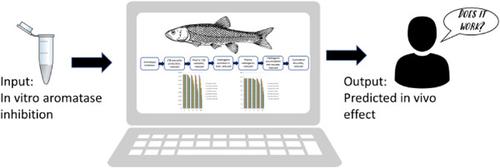当前位置:
X-MOL 学术
›
Environ. Toxicol. Chem.
›
论文详情
Our official English website, www.x-mol.net, welcomes your feedback! (Note: you will need to create a separate account there.)
Case Study in 21st Century Ecotoxicology: Using In Vitro Aromatase Inhibition Data to Predict Short‐Term In Vivo Responses in Adult Female Fish
Environmental Toxicology and Chemistry ( IF 4.1 ) Pub Date : 2020-12-17 , DOI: 10.1002/etc.4968 Daniel L Villeneuve 1 , Brett R Blackwell 1 , Jenna E Cavallin 1 , Wan-Yun Cheng 2 , David J Feifarek 3 , Kathleen M Jensen 1 , Michael W Kahl 1 , Rebecca Y Milsk 4 , Shane T Poole 3 , Eric C Randolph 4 , Travis W Saari 3 , Gerald T Ankley 1
Environmental Toxicology and Chemistry ( IF 4.1 ) Pub Date : 2020-12-17 , DOI: 10.1002/etc.4968 Daniel L Villeneuve 1 , Brett R Blackwell 1 , Jenna E Cavallin 1 , Wan-Yun Cheng 2 , David J Feifarek 3 , Kathleen M Jensen 1 , Michael W Kahl 1 , Rebecca Y Milsk 4 , Shane T Poole 3 , Eric C Randolph 4 , Travis W Saari 3 , Gerald T Ankley 1
Affiliation

|
The present study evaluated whether in vitro measures of aromatase inhibition as inputs into a quantitative adverse outcome pathway (qAOP) construct could effectively predict in vivo effects on 17β‐estradiol (E2) and vitellogenin (VTG) concentrations in female fathead minnows. Five chemicals identified as aromatase inhibitors in mammalian‐based ToxCast assays were screened for their ability to inhibit fathead minnow aromatase in vitro. Female fathead minnows were then exposed to 3 of those chemicals: letrozole, epoxiconazole, and imazalil in concentration–response (5 concentrations plus control) for 24 h. Consistent with AOP‐based expectations, all 3 chemicals caused significant reductions in plasma E2 and hepatic VTG transcription. Characteristic compensatory upregulation of aromatase and follicle‐stimulating hormone receptor (fshr) transcripts in the ovary were observed for letrozole but not for the other 2 compounds. Considering the overall patterns of concentration–response and temporal concordance among endpoints, data from the in vivo experiments strengthen confidence in the qualitative relationships outlined by the AOP. Quantitatively, the qAOP model provided predictions that fell within the standard error of measured data for letrozole but not for imazalil and epoxiconazole. However, the inclusion of measured plasma concentrations of the test chemicals as inputs improved model predictions, with all predictions falling within the range of measured values. Results highlight both the utility and limitations of the qAOP and its potential use in 21st century ecotoxicology. Environ Toxicol Chem 2021;40:1155–1170. © 2020 SETAC. This article has been contributed to by US Government employees and their work is in the public domain in the USA.
中文翻译:

21 世纪生态毒理学案例研究:使用体外芳香酶抑制数据预测成年雌鱼的短期体内反应
本研究评估了作为定量不良结果通路 (qAOP) 结构输入的芳香酶抑制的体外测量是否可以有效预测对雌性黑头鲦鱼体内 17β-雌二醇 (E2) 和卵黄素 (VTG) 浓度的影响。在基于哺乳动物的 ToxCast 测定中被鉴定为芳香酶抑制剂的五种化学物质在体外抑制黑头鲦芳香酶的能力进行了筛选。然后将雌性黑头鲦鱼暴露于其中 3 种化学物质:来曲唑、氧唑菌和抑霉唑的浓度反应(5 种浓度加对照)24 小时。与基于 AOP 的预期一致,所有 3 种化学物质均导致血浆 E2 和肝 VTG 转录显着降低。对于来曲唑,观察到卵巢中芳香化酶和促卵泡激素受体 (fshr) 转录物的特征性代偿性上调,而其他 2 种化合物则没有。考虑到终点之间浓度-反应的总体模式和时间一致性,来自体内实验的数据增强了对 AOP 概述的定性关系的信心。定量地,qAOP 模型提供的预测落在来曲唑测量数据的标准误差范围内,但对于抑霉唑和氧唑菌则没有。然而,将测试化学品的测量血浆浓度作为输入包括在内,改进了模型预测,所有预测都落在测量值的范围内。结果突出了 qAOP 的实用性和局限性及其在 21 世纪生态毒理学中的潜在用途。环境毒物化学2021;40:1155–1170。© 2020 SETAC。本文由美国政府雇员贡献,他们的工作在美国属于公共领域。
更新日期:2020-12-17
中文翻译:

21 世纪生态毒理学案例研究:使用体外芳香酶抑制数据预测成年雌鱼的短期体内反应
本研究评估了作为定量不良结果通路 (qAOP) 结构输入的芳香酶抑制的体外测量是否可以有效预测对雌性黑头鲦鱼体内 17β-雌二醇 (E2) 和卵黄素 (VTG) 浓度的影响。在基于哺乳动物的 ToxCast 测定中被鉴定为芳香酶抑制剂的五种化学物质在体外抑制黑头鲦芳香酶的能力进行了筛选。然后将雌性黑头鲦鱼暴露于其中 3 种化学物质:来曲唑、氧唑菌和抑霉唑的浓度反应(5 种浓度加对照)24 小时。与基于 AOP 的预期一致,所有 3 种化学物质均导致血浆 E2 和肝 VTG 转录显着降低。对于来曲唑,观察到卵巢中芳香化酶和促卵泡激素受体 (fshr) 转录物的特征性代偿性上调,而其他 2 种化合物则没有。考虑到终点之间浓度-反应的总体模式和时间一致性,来自体内实验的数据增强了对 AOP 概述的定性关系的信心。定量地,qAOP 模型提供的预测落在来曲唑测量数据的标准误差范围内,但对于抑霉唑和氧唑菌则没有。然而,将测试化学品的测量血浆浓度作为输入包括在内,改进了模型预测,所有预测都落在测量值的范围内。结果突出了 qAOP 的实用性和局限性及其在 21 世纪生态毒理学中的潜在用途。环境毒物化学2021;40:1155–1170。© 2020 SETAC。本文由美国政府雇员贡献,他们的工作在美国属于公共领域。



























 京公网安备 11010802027423号
京公网安备 11010802027423号